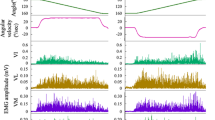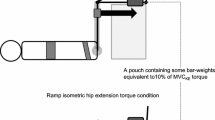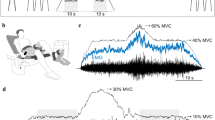Abstract
The purpose of this study was to determine if differences exist between the control strategies of two antagonist thigh muscles during knee flexion and extension muscular coactivation. Surface myoelectric signal (MES) of the quadriceps (rectus femoris) and the hamstrings (semitendinosus) were obtained from both muscles while performing step-wise increasing contractions during flexion and extension with the knee at 1.57 rad of flexion (90 degrees). The median frequency of the power density spectrum, which is related to the average muscle fiber action potential conduction velocity and therefore to motor unit recruitment, was calculated from each MES. The results suggest that, in all the subjects tested, when the muscle acts as antagonist most motor units are recruited up to 50% of the maximal voluntary force, whereas when the muscle acts as antagonist motor units are recruited up to 40% of the maximal voluntary force. The force range past 40–50% of the maximal force is also characterized by differences between the agonist/antagonist.
Similar content being viewed by others
References
Arendt-Nielsen L, Forster A, Mills KR (1984) EMG power spectral shift and muscle fibre conduction velocity during human muscle fatigue JPhysiol (Lond) 353:54
Baratta R, Solomonow M, Zhou BH, Letson D, Chuinard R, D'Ambrosia R (1988) Muscular coactivation. The role of the antagonist musculature in maintaining knee stability. Am J Sports Med 16:113–122
Basmajian J, DeLuca O (1985) Muscles alive, 5th edn. Williams and Wilkins, Baltimore
Bigland-Ritchie B, Donovan EF, Roussos C (1981) Conduction velocity and EMG power spectrum changes in fatigue of sustained maximal efforts J Appl Phys 51:1300–1305
Bilodeau M, Arsenault AB, Gravel D, Bourbonnais D, Kemp F (1991) Comparison of EMG power spectra while performing stepwise and ramp contractions. Electromyographical kinesiology. Elsevier, Amsterdam
De Luca C (1984) Myoelectric manifestations of localized muscular fatigue in humans. Crit Rev Biomed Eng 11:251–279
De Luca CJ, LeFever RS, McCue MP, Xenakis A (1982) Behaviour of human motor units in different muscles during linearly varying contractions. J Physiol (Lond) 329:113–128
Freund HJ, Budingen HJ, Deitz (1975) Activity of single motor units from human forearm muscles during voluntary isometric contractions. J Neurophysiology 38:933–946
Fuglevand AJ, Winter DA, Patla AE, Stashuk D (1992) Detection of motor unit potentials with surface electrodes: influence of electrode size and spacing. Biol Cybern 67:143–153
Hagood S, Solomonow M, Baratta R, Zhou BH, D'Ambrosia R (1990) The effect of joint velocity on the contribution of the antagonist musculature to knee stiffness and laxity. Am J Sports Med 18:182–187
Henneman E (1986) Peripheral mechanisms involved in the control of muscle. In: Mountcastle VB (ed) Medical physiology, 12th edn, C.-V. Mossby, St. Louis, pp 1697–1716
Henneman E, Somjen G, Carpentar DO (1965) Functional significance of cell size in spinal motoneurons. J Neurophysiol 28:560–580
Hirokawa S, Solomonow M, Lou Z, Lu Y, D'Ambrosia R (1991) Muscular co-contraction and control of knee stability. J Electromyogr Kinesiol 1:199–208
Hirokawa S, Solomonow M, Lu Y, Lou ZP, D'Ambrosia R (1992) Anterior-posterior and rotational displacement of the tibia elicited by quadriceps contraction. Am J Sports Med 20:299–306
Johnson MA, Polgar J, Weightman D, Appleton D (1973) Data on the distribution of fibre types in thirty-six human muscles. J Neurol Sci 18:111–129
Kadefors R, Kaiser E, Petersen (1968) Dynamic spectrum analysis of myopotentials with special reference to muscle fatigue. Electromyogr Clin Neurophysiol 8:39–74
Knaflitz M, Merletti R, De Luca C (1990) Inference of motor unit recruitment order in voluntary and electrically elicited contractions. J Appl Physiol 68:1657–1667
Kukulka C, Clamann HP (1981) Comparison of the recruitment and discharge properties of motor units in human brachialis biceps and adductor pollicis during isometric contractions. Brain Res 219:45–55
Lindstrom LR, Magnusson R, Petersen I (1970) Muscular fatigue and action potential conduction velocity changes studied with frequency analysis of EMG signals. Electromyogr Clin Neurophysiol 4:341–353
Lindstrom L, Kadefors R, Petersen I (1977) electromyographic index for localized muscle fatigue. J Appl Physiol 43:750–754
Merletti R, Knaflitz M, De Luca C (1990) J Myoelectric manifestations of fatigue in voluntary and electrically elicited contractions. J Appl Physiol 69:1810–1820
Merletti R, Sabbahi MA, De Luca CJ (1984) Median frequency of the myoelectric signals: effects of ischemia and cooling. Eur J Appl Physiol 52:258–267
Milner-Brown HS, Stein RB, Yemm R (1973a) The orderly recruitment of human motor units during voluntary isometric contractions. J Physiol (Lond) 230:359–370
Milner-Brown HS, Stein RB, Yemm (1973b) Changes in firing rate of human motor units during linearly changing voluntary contractions. J Physiol (Lond) 230:371–390
Mills KS (1982) Power spectral analysis of electromyogram and compound muscle action potential during muscle fatigue and recovery. J Physiol (Lond) 326:401–409
Sanchez JH, Solomonow M, Baratta RV, D'Ambrosia R (1993) Control strategies of the elbow antagonist muscle pair during two types of increasing isometric contractions. J Electromyogr Kinesiol 3:33–40
Solomonow M (1984) External control of the neuromuscular System. IEEE Trans Biomed Eng 31:752–763
Solomonow M, Baratta RV, Zhou BH, Bernardi M, Acierno S, (1994) Surface and wire EMG crosstalk in neighboring muscles. J Electromyogr Kinesiol 4:131–142
Solomonow M, D'Ambrosia R (1991) Neural reflex arcs and muscle control of knee stability and motion. In: Scott WN (ed) Ligament and extensor mechanism injuries of the knee. Mosby, St Louis, pp 389–400
Solomonow M, Guzzi A, Baratta R, Shoji H, D'Ambrosia R (1986) EMG-force model of the elbow antagonistic muscle pair. The effect of joint position, gravity and recruitment. Am J Phys Med 65:223–244
Solomonow M, Baten C, Smit J, Baratta R, Hermens H, D'Ambrosia R, Shoji H (1990) Electromyogram power spectra frequencies associated with motor unit recruitment strategies J Appl Physiol 68:1177–1185
Stulen FB, De Luca CJ (1981) Frequency parameters of the myoelectric signal as a measure of muscle conduction velocity. IEEE Trans Biomed Eng 28:515–523
Winter D (1994) Crosstalk in surface electromyography: theoretical and practical estimates. J Electromyogr Kinesio 4:15–26
Zhou B, Ding S, Liu P, Wu X (1990) Median frequency changes of elbow antagonist muscle pair during sustained constant force contraction. Proceedings of the 12th Annual International Conference. IEEE Eng Med Biol Soc 12:2217–2218
Zoutman EE (1989) Analysis of the surface EMG during voluntary contraction. The relationship between the median frequency of the power density spectrum of the EMG and the contraction level. M.Sc. Thesis, University of Twente, Enschede, The Netherlands
Author information
Authors and Affiliations
Rights and permissions
About this article
Cite this article
Bernardi, M., Solomonow, M., Sanchez, J.H. et al. Motor unit recruitment strategy of knee antagonist muscles in a step-wise, increasing isometric contraction. Europ. J. Appl. Physiol. 70, 493–501 (1995). https://doi.org/10.1007/BF00634378
Accepted:
Issue Date:
DOI: https://doi.org/10.1007/BF00634378




